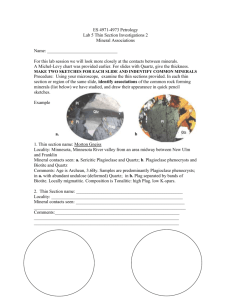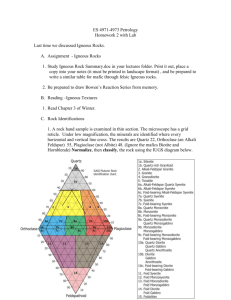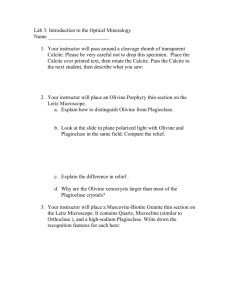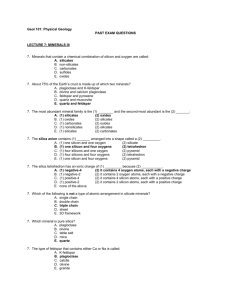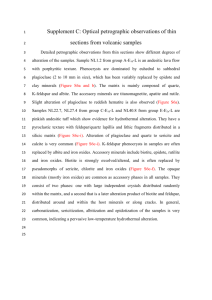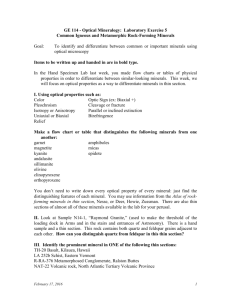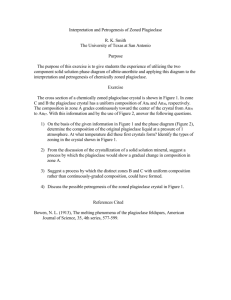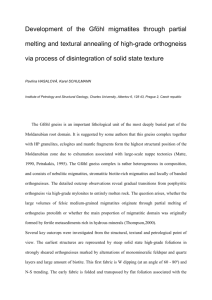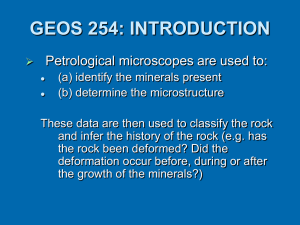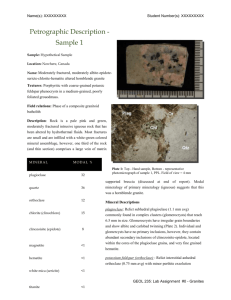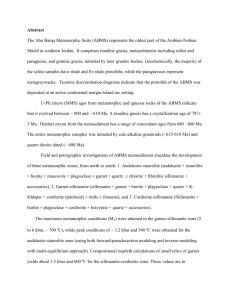Lab 3
advertisement
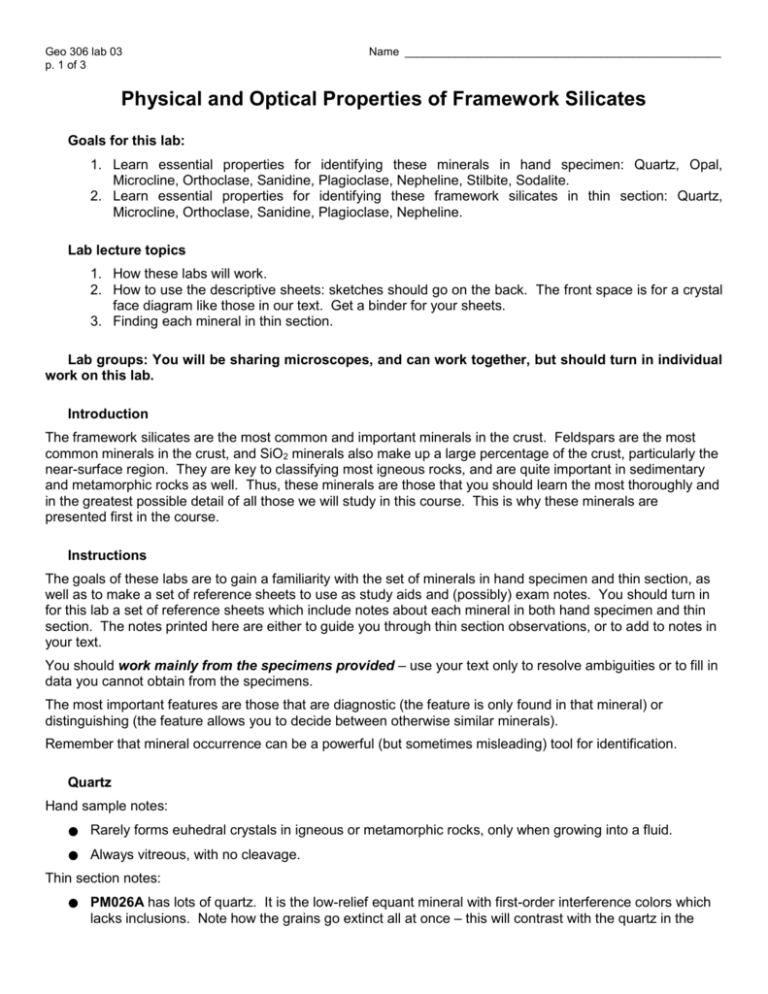
Geo 306 lab 03 p. 1 of 3 Name __________________________________________________ Physical and Optical Properties of Framework Silicates Goals for this lab: 1. Learn essential properties for identifying these minerals in hand specimen: Quartz, Opal, Microcline, Orthoclase, Sanidine, Plagioclase, Nepheline, Stilbite, Sodalite. 2. Learn essential properties for identifying these framework silicates in thin section: Quartz, Microcline, Orthoclase, Sanidine, Plagioclase, Nepheline. Lab lecture topics 1. How these labs will work. 2. How to use the descriptive sheets: sketches should go on the back. The front space is for a crystal face diagram like those in our text. Get a binder for your sheets. 3. Finding each mineral in thin section. Lab groups: You will be sharing microscopes, and can work together, but should turn in individual work on this lab. Introduction The framework silicates are the most common and important minerals in the crust. Feldspars are the most common minerals in the crust, and SiO2 minerals also make up a large percentage of the crust, particularly the near-surface region. They are key to classifying most igneous rocks, and are quite important in sedimentary and metamorphic rocks as well. Thus, these minerals are those that you should learn the most thoroughly and in the greatest possible detail of all those we will study in this course. This is why these minerals are presented first in the course. Instructions The goals of these labs are to gain a familiarity with the set of minerals in hand specimen and thin section, as well as to make a set of reference sheets to use as study aids and (possibly) exam notes. You should turn in for this lab a set of reference sheets which include notes about each mineral in both hand specimen and thin section. The notes printed here are either to guide you through thin section observations, or to add to notes in your text. You should work mainly from the specimens provided – use your text only to resolve ambiguities or to fill in data you cannot obtain from the specimens. The most important features are those that are diagnostic (the feature is only found in that mineral) or distinguishing (the feature allows you to decide between otherwise similar minerals). Remember that mineral occurrence can be a powerful (but sometimes misleading) tool for identification. Quartz Hand sample notes: Rarely forms euhedral crystals in igneous or metamorphic rocks, only when growing into a fluid. Always vitreous, with no cleavage. Thin section notes: PM026A has lots of quartz. It is the low-relief equant mineral with first-order interference colors which lacks inclusions. Note how the grains go extinct all at once – this will contrast with the quartz in the Geo 306 lab 3 p. 2 of 3 other rocks. This smooth extinction pattern indicates that the quartz was either never deformed, or it was deformed but then held at high temperature without any deformation for a while. SN14 has quartz along with plagioclase and K-feldspar. In this case the quartz grains do not go extinct all at once: parts of each grain go extinct at different positions. This is called “undulatory extinction” if it sweeps smoothly across the grain, or “discontinuous undulatory extinction” if there are faint boundaries between the regions. SN14 has discontinuous undulatory extinction. Although many other minerals can develop this texture, by far the most common occurrence of this texture is in quartz. I-S-21 also has grains of quartz amid the other minerals. Opal Hand sample notes: Not truly crystalline (really a mineraloid). Key is low density, often waxy luster. K-feldspar (Microcline) Hand sample notes: Often has perthitic exsolution visible in hand specimen: wispy elongate regions of different color. Sketch this texture. Often pink in granitoids. Thin section notes: I-S-21 has microcline (among other minerals) and much of it shows the “tartan” or cross-hatched twinning, which is diagnostic of microcline. Be sure to sketch this pattern on your reference sheet! Often slightly cloudy due to minor alteration to clays or sericite. K-feldspar (Orthoclase) Hand sample notes: Lacks perthitic exsolution visible in hand specimen. Thin section notes: SN14 shows perthitic exsolution visible in thin section: wispy elongate regions that go extinct differently. Sketch this texture. It also shows alteration to clays/sericite which makes it cloudy in PP light. Often slightly cloudy due to minor alteration to clays or sericite. K-feldspar (Sanidine) Hand sample notes: Lacks perthitic exsolution visible in hand specimen. Principally occurs in volcanic rocks as phenocrysts (requires fast cooling from high temperature). Thin section notes: We currently have no sanidine-bearing thin sections. Plagioclase Hand sample notes: Geo 306 lab 3 p. 3 of 3 Cleavage surfaces display striations, very fine perfectly parallel lines that resemble scratches. This is diagnostic of plagioclase. Thin section notes: IPm37 is dominated by plagioclase. Most of the colorless, low-relief minerals are plagioclase. The dominant XP feature observed in these is the stripes, which are caused by twinning (we’ll learn about his later). These twins can be used to infer the specific composition of the plagioclase – your text describes two methods for this. There are actually two types of twins: the closelyspaced, rhythmic twins are called “polysynthetic” twins or sometimes just “albite” twins; the twins which separate a grain into two large regions are called “Carlsbad” twins. Note that this rock contains olivine. Think about whether we would expect the plagioclase to be closer to albite or anorthite in compositon, according to Bowen’s reaction series, which you learned in earlier courses (I hope). Also, this rock contains patches of myrmekite. Myrmekite is not a mineral but an wormy intergrowth of quartz and plagioclase that occurs at the boundary between plagioclase and Kfeldspar. Examine a few and decide whether the myrmekite is growing from the boundary into both minerals equally, or just the plagioclase or just the K-feldspar. Sketch this texture. SN14 also contains myrmekite. It has a very interesting plagioclase texture, though, in which concentric shapes appear when the grain is near extinction. This is caused by regions of the crystal being slightly different composition, which makes them go extinct at slightly different angles. It occurs as a result of changing conditions during igneous crystallization, so it is called growth zoning. Sketch an example of this texture. Nepheline (a feldspathoid) Hand sample notes: Looks a good deal like feldspars, but has a greasy luster on fresh surfaces. Thin section notes: I-S-47 contains a good deal of nepheline, but it is largely altered to clays. Most of the clear low-relief material is feldspar, both plagioclase (has polysynthetic twins) and K-feldspar (no twins). It is nearly impossible to distinguish from feldspar and quartz without conoscopic techniques. Sodalite (a feldspathoid) Hand sample notes: Vibrant blue color, low density Stilbite (a zeolite) Hand sample notes: Typically forms on the surfaces of voids in igneous rocks as a precipitate from hydrous fluids. Distinctive sheaf-like shapes (like a sheaf of wheat tied in the middle) Sketch one of these shapes.
